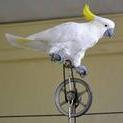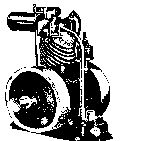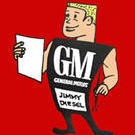-
Content Count
1,444 -
Joined
-
Last visited
-
Days Won
130
Reputation Activity
-
 Wallfish reacted to Mike in NC in Newest Addition to my Wife's collection
Wallfish reacted to Mike in NC in Newest Addition to my Wife's collection
Here is the newest addition to her O&R collection. It has a 12VDC port, a 120VDC, and a 120VAC outlet. We bought this from a friend.
-
 Wallfish reacted to CNew in Newest Addition to my Wife's collection
Wallfish reacted to CNew in Newest Addition to my Wife's collection
Very cool, great addition to the collection. I was just thinking the other day that things have been a little quiet on here for O&R finds. I’m certainly not having a lot of luck finding any these days. Glad you landed that little generator!
-
 Wallfish reacted to Mitch in carberator parts
Wallfish reacted to Mitch in carberator parts
I repaired the recoil, cleaned and gapped the points, repaired the spark plug wire and put a little gas in the carb and it fired right up. I forgot to plug in a drop light but I will tomorrow as I ran out of time. I will need a diaphragm carb kit, its stiff and dried out. B ut all the parts are there. Except of course the main jet.I don't think I need a reed valve.
-
 Wallfish got a reaction from Yevick in Ohlsson & Rice loose red wire
Wallfish got a reaction from Yevick in Ohlsson & Rice loose red wire
The springs can go in and out so they just need to be set back in place as long as they aren't broken. I don't remember ever seeing a distinct clutch assembly drawing but there may be one on here somewhere, I just couldn't find one. There are a couple of different clutch setups so not knowing exactly what you are working with makes any details or advice difficult. How about posting a picture of it?
-
 Wallfish got a reaction from Yevick in Ohlsson & Rice loose red wire
Wallfish got a reaction from Yevick in Ohlsson & Rice loose red wire
The wire should go to a kill switch button on the handle to shut down the engine by grounding the coil. Location of the switch depends on the model.
One port is an air vent. It goes from the bottom of the tank to just inside of the fuel cap. The other port is the fuel feed to the carb.
More than likely it will need a new carb diaphragm to run or run correctly. Check the air filter BEFORE trying to start it. If it has that old crusty material inside, it will need to be thoroughly cleaned out. Otherwise it will be sucked into the engine. Not good.
If you use the search feature you can find other threads on the Drillgine drills.
Here's a link to the search results for "Drillgine" in topics only. There are threads on the early reds and later yellows
https://myoldmachine.com/search/?q=drillgine&quick=1&type=forums_topic
-
 Wallfish got a reaction from brad2921 in O&R Engine rebuild pics
Wallfish got a reaction from brad2921 in O&R Engine rebuild pics
Re use them if possible. I've reused many without issue if they were not damaged
If they were damaged, search "High Temp gasket material" to cut your own. The O ring isn't anything special and can be found with a search for that size as well
-

-
 Wallfish reacted to WILF in O&R Tarpen tools
Wallfish reacted to WILF in O&R Tarpen tools
Hi I have just acquired a Q&R 1hp engine with a tarpen flex workhead i am very interested in the chain saw attachment.
I'm based in north Somerset Nr Bristol.
-
 Wallfish got a reaction from UnicycleParrot in O&R Questions
Wallfish got a reaction from UnicycleParrot in O&R Questions
RPM at full throttle is 6300 So yeah, they scream a little bit
Governor is never "guaranteed" but they seem to work very well. I've never had one fail while the engine is running. It's controlled by the spring on the bottom of the carb. No adjustments are available on those older versions. Newer ones have a lever that can adjust tension on the spring
Diaphragm should be soft and pliable for best results. Wrinkles indicate it's probably old and stiff.
-
 Wallfish reacted to UnicycleParrot in O&R Questions
Wallfish reacted to UnicycleParrot in O&R Questions
I'm back!!!
I have had a busy summer, and i am finally getting around to posting this.
I have replaced the crusty old spark plug insulation (2 layers of shrink tubing)
Also, I had problems with fuel system, so I properly modified it. (maybe epoxy isn't proper I guess)
Also, because I have access to a mill, I can make a compex shape for a motor mount.
I also have one question.
Is the air vane governor guaranteed to work?
I say this because I had it running today, and it sounded like it was trying to go pretty fast (maybe hitting 2000rpm)
Now, I know that these engines can hit around 5000rpm idle, I just didn't have my tach hooked up at the moment, and I didn't want to risk any damage.
Can I just start it up and then walk away expecting the governor to work first time without any tweaking?
Also, should my carburetor diaphragm be kind-of wrinkly? I believe it is the original diaphragm and it has not been replaced.
Thanks
-
 Wallfish got a reaction from Mike in NC in O&R Tarpen tools
Wallfish got a reaction from Mike in NC in O&R Tarpen tools
Those Tarpen tools are definitely cool and they look very well built. I'd like to find some for my collection but doubt there are very many out there.
-
 Wallfish reacted to pmackellow in New Addition to my Wife's collection
Wallfish reacted to pmackellow in New Addition to my Wife's collection
Here's my one in the display shed with the other O&R powered machines (amongst other things)...
Paul
-
 Wallfish reacted to Mike in NC in New Addition to my Wife's collection
Wallfish reacted to Mike in NC in New Addition to my Wife's collection
Here is her newest addition. It is an Aquabug with the electric conversion. I will get pictures of the electric later.
-
 Wallfish reacted to Mike in NC in O&R Display at a Show
Wallfish reacted to Mike in NC in O&R Display at a Show
Here is my wife's O&R display at our local show this year. It was before she got the Aquabug boat engine.
-

-
 Wallfish reacted to Tom C in Micro Power mini bike build
Wallfish reacted to Tom C in Micro Power mini bike build
Have you guys come across this tiny mini bike called a BIG ELEPhANT? It was built in Japan and uses a Tas P7 engine or have seen one with a Tas S22? Here is a photo of the original sales brochure and it has a Big Elephant sitting on the seat of a 1969/70 Honda CB750 which probably dates it pretty well!
-
 Wallfish got a reaction from Mike in NC in Aquabug surprise!
Wallfish got a reaction from Mike in NC in Aquabug surprise!
I do remember someone posted one that could switch back and forth from gas to electric but I cannot seem to find it now.
It could've been way back on the old forum before we switched to here. Lots of that info was lost
-
 Wallfish got a reaction from Mike in NC in Let's rebuild another one/ Amp Champ
Wallfish got a reaction from Mike in NC in Let's rebuild another one/ Amp Champ
guess it would help to put the gas tank on. ooops! Good thing I looked at the pic on the screen
-
 Wallfish got a reaction from ozyboy84 in Trying to sell Unknown model O&R
Wallfish got a reaction from ozyboy84 in Trying to sell Unknown model O&R
New member @Sinclair is from Australia. You can try contacting him through Private Message. Click on the little envelope icon on the top right corner.
The small water pump is missing.
-
 Wallfish got a reaction from CNew in repairing broken starter dogs
Wallfish got a reaction from CNew in repairing broken starter dogs
Well, got one done anyway. Took much longer to do than anticipated.
I cut some of that blue spring steel I ordered for making the carb springs. The first stuff I ordered was too thick for the carb springs and it finally found a purpose. Sliced a long thin piece off then heated and bent the edge of it into a circle to fit in the dogleg hole. Drilled out the old stuff. Put the new spring in place then dropped solder in. The bubble of solder was big so I also hammered it so it would stay very tight. Filed off the remainder and cut the spring to length. Seems to work well. UGH, only 7 more to go!
I like that gun bluing stuff so I'll probably clean them all up and coat them with that too.
-
 Wallfish got a reaction from K-TRON in Homelite XL Tool collection
Wallfish got a reaction from K-TRON in Homelite XL Tool collection
Finally found the last item I'm aware of for the collection. These Lewis winches were made for Homelite and these blue ones seem to be super rare. It's the same winch as the common orange units but the blue Homelite paint makes it a better fit for the collection.
Just need the small drive belt which the seller forgot to add in the box but is sending. Probably find a nicer power head to switch this on to as well.
-
 Wallfish got a reaction from K-TRON in Homelite XL Tool collection
Wallfish got a reaction from K-TRON in Homelite XL Tool collection
Found another tool for the collection. A Homelite XL-100G-1A. Basically the same as an XL-100 circular saw but with a grinder wheel instead of a saw blade but doesn't come with flat guide to ride on. Not in the best of condition concerning the paint but this is the only one I've ever seen so...
-
 Wallfish got a reaction from K-TRON in Homelite XL Tool collection
Wallfish got a reaction from K-TRON in Homelite XL Tool collection
Also have this Cutoff saw grinder. Same idea as the XL-100G but this is an attachment to the chainsaw compared to a specific manufactured tool.
-
 Wallfish got a reaction from K-TRON in repairing broken starter dogs
Wallfish got a reaction from K-TRON in repairing broken starter dogs
Well, got one done anyway. Took much longer to do than anticipated.
I cut some of that blue spring steel I ordered for making the carb springs. The first stuff I ordered was too thick for the carb springs and it finally found a purpose. Sliced a long thin piece off then heated and bent the edge of it into a circle to fit in the dogleg hole. Drilled out the old stuff. Put the new spring in place then dropped solder in. The bubble of solder was big so I also hammered it so it would stay very tight. Filed off the remainder and cut the spring to length. Seems to work well. UGH, only 7 more to go!
I like that gun bluing stuff so I'll probably clean them all up and coat them with that too.
-
 Wallfish reacted to WILF in Older style recoil handles
Wallfish reacted to WILF in Older style recoil handles
Hi Wallfish.
Thank you so much for the information and advice. I now have the recoil back together and working. My next step is to get the drill running. I will let you know how I get on 😎






